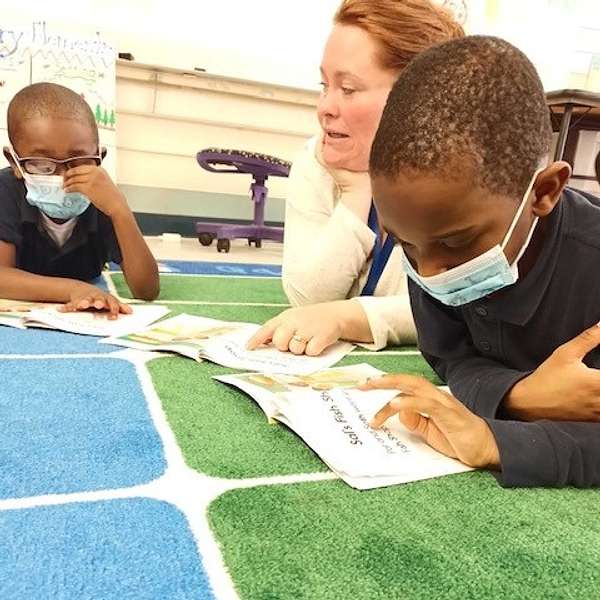
Opportunity Culture Audio
Opportunity Culture Audio
#2. Teacher-Assistant Partnership Helps Students Grow
Angela Caldwell, an Opportunity Culture expanded-impact kindergarten teacher in Guilford County, North Carolina, and her teaching assistant, Lora Terry, speak with Public Impact about their teaching partnership and the impact they see small-group tutoring making on student learning growth. Listen as they share their tips for creating a successful partnership!
In August 2021, Angela Caldwell, an Opportunity Culture expanded-impact kindergarten teacher at Montlieu Academy of Technology in Guilford County, North Carolina, found herself unexpectedly on her own with a classroom of 22 students, after her teaching assistant left just as the school year began.
So she felt relief that fall when interviewing Lora Terry, who had worked for many years in day care settings. The two clicked, Caldwell said, with Terry making it very clear what she would need to do the job of an assistant well—clear expectations, communication, and clarification.
That felt just right to Caldwell, who took those needs to heart as she prepared for Terry to begin just before winter break.
“We work extremely well together,” Caldwell said. “I know when she first came on, I had just taken the time to write down detailed, time-by-time, what the expectations were, what I needed her to be doing, what groups that she needed to be pulled, what skill those kids needed. And really, she just needed a frame of what to do.”
Terry spends much of the day working with small groups as students rotate through small-group and independent-learning stations. During whole-group lessons, she moves among students to help them as needed, or note for Caldwell when students need more.
“She’s never sitting at her desk—never,” Caldwell said. “She’s always up there with the kids pulling groups. Like, let’s say we’re doing independent work—I’ve typically got about three or four that still struggle with different standards being taught; she’ll either pull them back here to her table and work with them during their independent time or she pulls up a chair at their table and will help them with it.”
Of all she does during the day, Terry believes her small-group work has the most impact on student growth—and her sense of that jibes with research showing the power of small-group tutoring by paraprofessionals.
“You can see the positive influence it is just having, you know, one-on-one attention with three or four students,” she said.
Although they have no time during the day to plan together—when not needed in Caldwell’s classroom, Terry assists a first-grade teacher with similar small groups—Terry has what she needs from the organized materials Caldwell created for her.
Those include a shelf of materials, individually packaged and labeled according to the state instructional standard each packet addresses. As they’ve settled into each other’s working styles, Caldwell has also given Terry flexibility to modify materials or try another strategy when she sees a student need—to “amp it up,” Terry says, to keep students excited about learning.
Terry quickly built strong relationships with the students, Caldwell said, and they sense that in students’ growing confidence to learn and make mistakes. Terry is especially good at helping the students who are struggling the most as they learn to read, Caldwell said. After several months together, they’re seeing strong student learning growth.
“We have one common goal. Our common goal is that these kids are successful and that they know what it feels like,” she said. “They know that we love them and that we believe in them, to the point when I call on a kid to try something, you have our own students saying, ‘we believe in you, you can do it,’” Caldwell said.
Terry said she would advise other incoming assistants to “find out what the expectations are and have open communication if something is not working, talk to the person that you’re working with and let them know..…So the biggest thing I would tell them is definitely communication, and the second-biggest thing is sharing what each other’s expectations are—with those two things you’re going to be successful.”
Caldwell gushes about how quickly their working relationship has gelled. “She’s really fantastic—she has definitely exceeded expectations, for sure.”
And Terry says her first job in the public schools has been a dream.
“I just wanted my life to make an impact… and I felt like here, I could make the greatest impact,” she said. “I was terrified to try something different, and it’s been the best thing for me. I feel like my whole life has changed.”
Caldwell and Terry’s Keys to Success
Set expectations in the job interview: For Caldwell, being able to describe what she needed and hear Terry respond with how she would support Caldwell—and what she, in turn, would need to be a successful assistant—proved a valuable first step in creating a positive relationship that worked from the start.
Consistently communicate expectations: This is everything, Terry said. Caldwell’s clear communication leaves little to chance or surprise; Terry knows what to expect, when, every day, for both herself and Caldwell. And Terry is careful to communicate her own expectations, letting Caldwell know how much guidance she needs.
Take the time to prepare detailed materials: Caldwell’s materials make it easy for Terry to jump into work with students despite not being able to plan together, and during whole-class lessons, Terry pays close attention to Caldwell’s content and instructional style, so that she feels confident in her work afterward with small groups.
Continue to clarify: Caldwell and Terry trust each other, and both expect the other to clarify any misunderstandings or missteps in the classroom, never shoving them aside or griping about them to others.